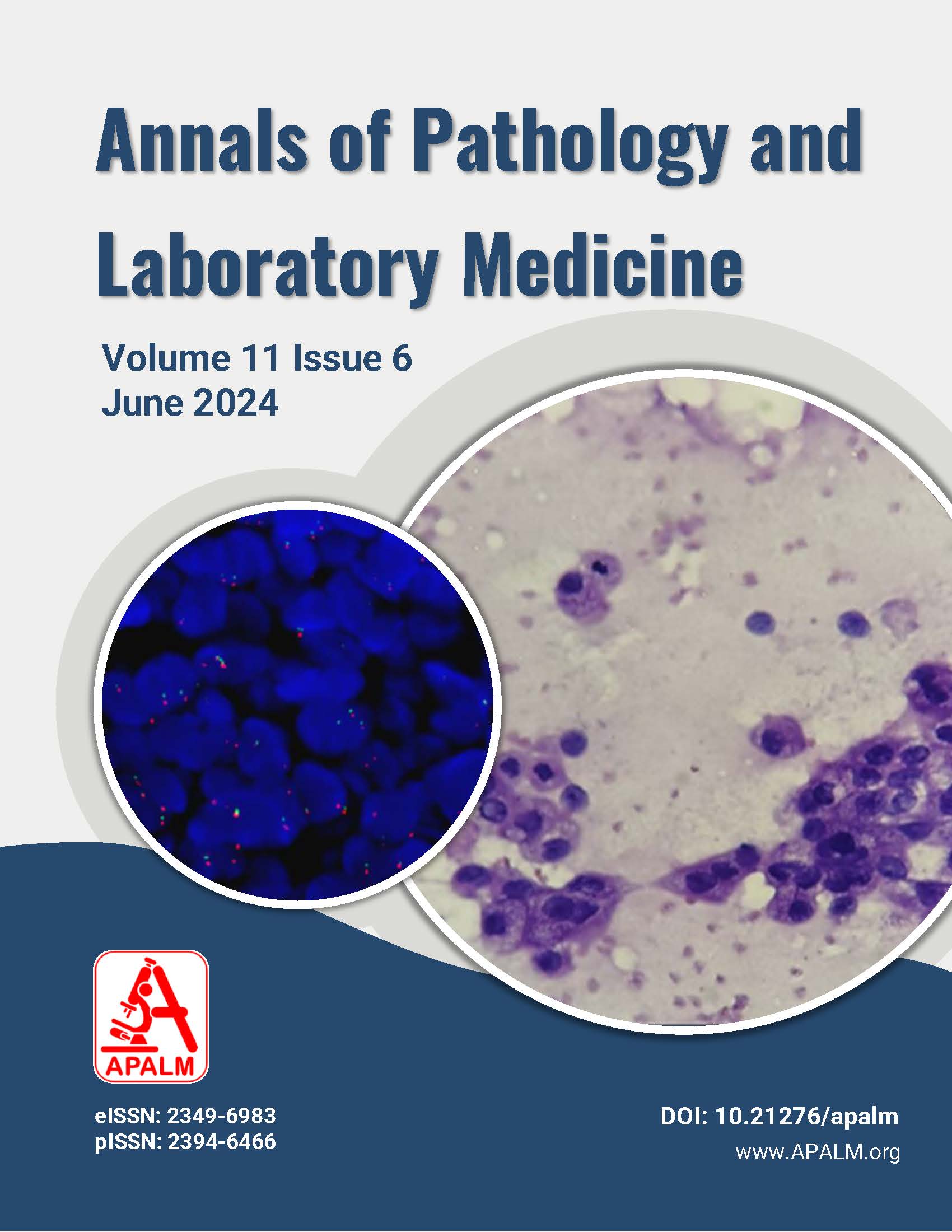A Comparative Study on Diagnostic Efficacy of WBC Parameters, Platelet Count, C-Reactive Protein, and Serum Ferritin in Early Onset and Late Onset Neonatal Sepsis
DOI:
https://doi.org/10.21276/apalm.3363Keywords:
early onset sepsis, late onset sepsis, neonatal sepsis, C-reactive protein, haematological parameters, toxic granulationsAbstract
Background
Early detection of neonatal sepsis is complicated due to vague symptoms and variations based on gestational age. Rapid identification is vital, and low-cost diagnostic tools like WBC parameters, platelet count, serum ferritin, and C-reactive protein (CRP) can speed up time-sensitive diagnosis. This can mitigate antibiotic resistance and overuse, cutting expenses in underdeveloped regions of India.
Material and Methods
Ninety cases of neonates <90 days [clinically suspicious admitted cases of early onset (EOS) and late onset neonatal sepsis (LOS): 30 cases each and 30 controls] were selected post-September 01, 2022, for the cross-sectional comparative study. Blood samples were obtained upon clinical suspicion of sepsis, prior to antibiotic treatment, and the above-mentioned parameters were analyzed.
Results
Preterm births constituted 20% (EOS), 36% (LOS), and 26% (control). Low birth weight occurred in 36% (EOS), 33% (LOS), and 23% (control); females represented 46% (EOS), 53% (LOS), and 53% (control). Culture-positive cases were 14 (EOS) and 19 (LOS). Notable variations emerged in CRP, I/T ratio, and toxic granules. The combined analysis of EOS and LOS indicated CRP's sensitivity at 78%, specificity at 90%, PPV at 94%, and NPV at 68%. I/T ratio exhibited 72% sensitivity, 97% specificity, 98% PPV, and 64% NPV. Toxic granules demonstrated 50% sensitivity, 97% specificity, 97% PPV, and 50% NPV, showcasing their diagnostic potential across various onset patterns.
Conclusion
For early-onset sepsis, the I/T ratio and toxic granules displayed significant utility, while CRP emerged as a standout performer for late-onset cases. On the whole, CRP emerged as the premier standalone marker, adaptable for pairing in early onset and singly for late onset, with commendable efficacy. Remarkable disparities in ferritin values between septic and non-septic groups call for further exploration of ferritin's diagnostic applicability.
References
Saboohi E, Saeed F, Khan RN, Khan MA. Immature to total neutrophil ratio as an early indicator of early neonatal sepsis. Pak J Med Sci Q [Internet]. 2019;35(1):241–6.
Abdelmoktader A, Hussein S, Ali D, Eisa O. Diagnostic value of eosinopenia and neutrophil to lymphocyte ratio in early onset neonatal sepsis. Fayoum Univ Med J [Internet]. 2020;7(1):161–71.
Rohil A, Dutta S, Varma N, Sachdev MS, Bansal A, Kumar P. Cell-surface biomarkers, C-reactive protein and hematological parameters for diagnosing late-onset sepsis in pre-term neonates. J Trop Pediatr. 2021;67(1).
Li X, Li T, Wang J, Feng Y, Ren C, Xu Z, et al. Clinical value of C-reactive protein/platelet ratio in neonatal sepsis: A cross-sectional study. J Inflamm Res [Internet]. 2021;14:5123–9.
Jethani S, Bhutani N, Yadav A. Diagnostic utility of combined immature and total neutrophil counts along with C-reactive protein in early detection of neonatal sepsis: A cross-sectional study. Ann Med Surg (Lond) [Internet]. 2022;77:103589.
Worku M, Aynalem M, Biset S, Woldu B, Adane T, Tigabu A. Role of complete blood cell count parameters in the diagnosis of neonatal sepsis. BMC Pediatr [Internet]. 2022;22(1):411.
Mannan MA, Shahidullah M, Noor MK, Islam F, Alo D, Begum NA. Utility of CRP and haematological parameters in detection of neonatal sepsis. Mymensingh Med J. 2010;19(2):259–63.
Shyamala K, Subbalakshmi NK, Raghuveera K. Role of platelet count and CRP level in Gram negative versus Gram positive bacterial sepsis in low birth weight neonates. J Chin Clin Med. 2010;5(8):474–9.
Alexejew B, Handrick W, Braun B, Domule M, Winiecki P. [Paediatr Grenzgeb. 1990;26(6):443–54. German].
Godula-Stuglik U, Skałba P, Witalis J. Evaluation of serum ferritin levels in newborn infants with septicemia and pneumonia. Pediatr Pol. 1986;61(12):798–802.
Downloads
Published
Issue
Section
License
Copyright (c) 2024 Naqsh Thakur, Prakash M Patil, Siddu Charki, Surekha B Hippargi

This work is licensed under a Creative Commons Attribution 4.0 International License.
Authors who publish with this journal agree to the following terms:
- Authors retain copyright and grant the journal right of first publication with the work simultaneously licensed under a Creative Commons Attribution License that allows others to share the work with an acknowledgement of the work's authorship and initial publication in this journal.
- Authors are able to enter into separate, additional contractual arrangements for the non-exclusive distribution of the journal's published version of the work (e.g., post it to an institutional repository or publish it in a book), with an acknowledgement of its initial publication in this journal.
- Authors are permitted and encouraged to post their work online (e.g., in institutional repositories or on their website) prior to and during the submission process, as it can lead to productive exchanges, as well as earlier and greater citation of published work (See The Effect of Open Access at http://opcit.eprints.org/oacitation-biblio.html).










